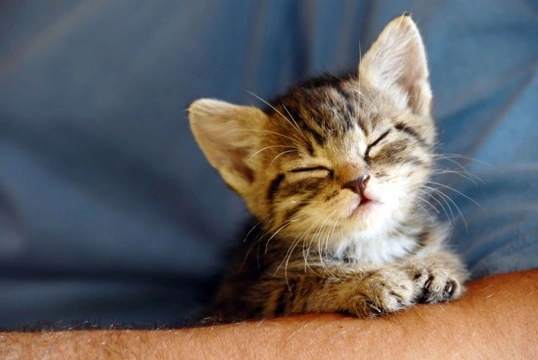
Why do cats purr?
There’s something very reassuring for cat lovers about having a sleepy, purring cat on their lap, but have you ever wondered why a cat purrs and how it makes that sound when it is apparently fast asleep? All members of the cat family are able to purr, even lions and tigers living in the wild! The sound of a cat’s miaow is produced in a similar way to that of the human voice, with air passing over the vocal chords in the larynx (or voice box), which is part of the respiratory tract in the throat, and which causes them to vibrate. Air passes to and from the lungs along the respiratory tract, and the shorter the vocal chords, the higher the pitch because of the greater amount of tension. However, purring is slightly different to miaowing, as although it still originates in the larynx, it consists of rapid bursts of sound that are due to the sudden release of air pressure that results from the separation of the left and right vocal chords. The muscles in the larynx are briefly stimulated by nerve impulses and domestic cats purr at an average of 25 to 250 times a second when they are breathing in or breathing out. The intensity of the purring often depends on how much the cat is being stimulated, such as by being stroked or even being spoken to by a favoured human. Kittens are able to purr from about a week old, and when they are feeding from their mother they can communicate their contentment by this means - they can even purr whilst they are suckling, without having to let go of their lunch! As kittens grow older they use purring to signal a feeling of well-being in a variety of situations, and mother cats will often purr to let their offspring know that all is well and reassure them that they are safe. Adult cats use purring as a greeting and sign of affection to other cats and also to their humans. In homes where there are two or more cats, a natural hierarchy will usually form with one cat assuming the role of leader, and in this situation purring may be used between a young cat and the dominant feline to show that they wish to play, or the older cat may reassure its younger housemate that he means no harm. Older cats almost return to their kittenhood sometimes when communicating with their humans by purring whilst they rub their heads around their owner’s legs, or when they are sitting happily on a lap. They also purr when they asleep, particularly when they are warm and comfortable in front of the fire or perched on their favourite spot near a radiator. Sometimes they even ‘knead’ with their paws at the same time, just as they did when they were kittens, to indicate how happy they are. This reaction can sometimes be seen if your cat is sitting on a fluffy rug or curled up with a cuddly toy, when they are obviously feeling relaxed and maybe it triggers an early memory of being with their mother. You will often hear cats purring when they are eating their meals, especially when it is one of their favourite dishes, and when they are really ecstatic about their food, they sometimes make an appreciative low growling noise at the same time! They will even purr in anticipation of the arrival of dinner, especially when they can see you preparing their meal for them, but this reaction tends to occur only when their favoured human is feeding them rather than somebody who might do it when you’re away. However, purring doesn’t always indicate a feeling of well-being, and recent research suggests that cats release endorphins when they purr, a natural analgesic that helps to reduce pain when they aren’t feeling well. Cats often purr when they are injured, ill or afraid which may indicate that they feel threatened in some way, and it is thought that purring is a self-soothing sound that reassures the inner cat. In situations like these, deep purring is more of a way of asking for help instead of communicating that all is well with their world. Some cats seem to purr less as they get older, although interestingly, they have a greater range of purring sounds than they had when they were very young. The sound of a cat purring can also be a reassuring sensation for humans when they are unhappy or ill, and many cats have shown themselves to be very sensitive to the moods and needs of their owners, sitting close to them in times of distress and purring loudly. If a human has a specific pain, the sensation of purring near the affected area has been shown to reduce that pain by the vibrations it causes. It is also thought that a purring cat can help to reduced raised blood pressure, particularly in older people, and cats are sometimes approved as having healing qualities in retirement homes and hospices, although obviously this would need to be a cat with a calm disposition. Purring definitely seems to be a voluntary sound when a cat actively wants to communicate pleasure and happiness, similar to the way that humans laugh or smile, and dogs wag their tails, and they seem able to transmit their feeling of wellbeing to their humans.



